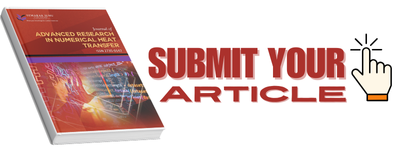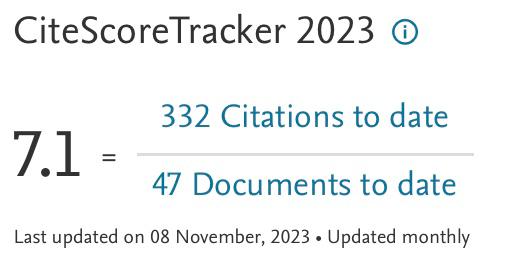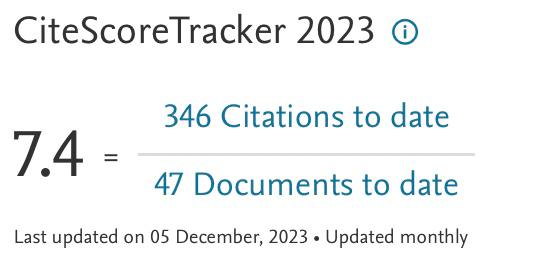Comparison of Modified and Classical Hamilton-Crosser Models for MWCNT-Water Nanofluid Heat Transfer Rate
DOI:
https://doi.org/10.37934/arnht.22.1.5972Keywords:
Hamilton-Crosser model, Model modification, Heat transfer rate, Thermal conductivityAbstract
The classical Hamilton-Crosser model is used to calculate the thermal conductivity of nanofluids. This thermal conductivity is controlled by the volume fraction of nanoparticles. However, the classical model encounters limitations when dealing with situations that include high concentrations of particles and a wide range of nanoparticle shapes. Researchers have acknowledged these limitations and have made modifications to the classical model to improve its accuracy and applicability. This research aims to compare the modified model with the classical Hamilton-Crosser model, focusing on the heat transfer rate of multi-walled carbon nanotube (MWCNT) water-based nanofluid. The governing equations were converted into ordinary differential equations using similarity variables and solved using the bvp4c function in MATLAB. The numerical solutions generated using bvp4c investigate the impact of a magnetic field, viscous dissipation, nanoparticle volume fraction, surface transpiration rate, length of MWCNT, and diameter of MWCNT. The findings suggest that the modified model reliably forecasts elevated heat transfer rates in comparison to the classical model. In addition, increased lengths of MWCNTs result in elevated rates of heat transfer. In contrast, as the diameter of MWCNTs increases, there is a progressive reduction in heat transmission rates. Therefore, the research suggests that the revised model is very well suited for identifying the ideal diameters of nanotubes to improve heat transfer efficiency. The results enhance the accuracy of thermal conductivity models and further the comprehension of nanofluid heat transfer properties.
Downloads
References
Choi, S. US, and Jeffrey A. Eastman. Enhancing thermal conductivity of fluids with nanoparticles. No. ANL/MSD/CP-84938; CONF-951135-29. Argonne National Laboratory (ANL), Argonne, IL (United States), 1995. https://www.osti.gov/biblio/196525
Jamil, Muhammad Mahmud, Nor Azwadi Che Sidik, Umar Sanusi Umar, and Muhammad Tukur Hamisu. “Carbon nanotube for solar energy applications: A review.” Journal of Advanced Research in Fluid Mechanics and Thermal Sciences 56, no. 2 (2019): 233-247.
Patel, Jatin, Abhishek Soni, Divya P. Barai, and Bharat A. Bhanvase. “A minireview on nanofluids for automotive applications: Current status and future perspectives.” Applied Thermal Engineering 219 (2023): 119428. https://doi.org/10.1016/j.applthermaleng.2022.119428 DOI: https://doi.org/10.1016/j.applthermaleng.2022.119428
Wang, Xiaoming, Yuxiang Song, Changhe Li, Yanbin Zhang, Hafiz Muhammad Ali, Shubham Sharma, Runze Li et al., “Nanofluids application in machining: a comprehensive review.” The International Journal of Advanced Manufacturing Technology (2023): 1-52. https://doi.org/10.3390/nano12234214 DOI: https://doi.org/10.3390/nano12234214
Harris, Peter JF. “Carbon nanotube composites.” International Materials Reviews 49, no. 1 (2004): 31-43. http://dx.doi.org/10.1179/095066004225010505 DOI: https://doi.org/10.1179/095066004225010505
Rout, H., S. S. Mohapatra, Sachin Shaw, V. S. Pandey, and M. K. Nayak. “Entropy optimized electrohydromagnetic rotating flow of non Newtonian fluid with suspension of SWCNT/MWCNT nanomaterials: modified Hamilton Crosser model.” Journal of Nanofluids 11, no. 1 (2022): 1-16. https://doi.org/10.1166/jon.2022.1815 DOI: https://doi.org/10.1166/jon.2022.1815
Suhaimi, Nur Sabrina, Muhamad Faiz Md Din, Mohd Taufiq Ishak, Abdul Rashid Abdul Rahman, Jianli Wang, and Muhammad Zahir Hassan. “Performance and limitation of mineral oil-based carbon nanotubes nanofluid in transformer application.” Alexandria Engineering Journal 61, no. 12 (2022): 9623-9635. https://doi.org/10.1016/j.aej.2022.02.071 DOI: https://doi.org/10.1016/j.aej.2022.02.071
Prabakaran, R., S. Eswaramoorthi, Karuppusamy Loganathan, and Ioannis E. Sarris. “Investigation on thermally radiative mixed convective flow of carbon nanotubes/Al2O3 nanofluid in water past a stretching plate with joule heating and viscous dissipation.” Micromachines 13, no. 9 (2022): 1424. https://doi.org/10.3390/mi13091424 DOI: https://doi.org/10.3390/mi13091424
Alsagri, Ali Sulaiman, Saleem Nasir, Taza Gul, Saeed Islam, K. S. Nisar, Zahir Shah, and Ilyas Khan. “MHD thin film flow and thermal analysis of blood with CNTs nanofluid.” Coatings 9, no. 3 (2019): 175. https://doi.org/10.3390/coatings9030175 DOI: https://doi.org/10.3390/coatings9030175
Liu, Min-Sheng, Mark Ching-Cheng Lin, I-Te Huang, and Chi-Chuan Wang. “Enhancement of thermal conductivity with carbon nanotube for nanofluids.” International Communications in Heat and Mass Transfer 32, no. 9 (2005): 1202-1210. https://doi.org/10.1016/j.icheatmasstransfer.2005.05.005 DOI: https://doi.org/10.1016/j.icheatmasstransfer.2005.05.005
Kumaresan, V., R. Velraj, and Sarit K. Das. “Convective heat transfer characteristics of secondary refrigerant based CNT nanofluids in a tubular heat exchanger.” International Journal of Refrigeration 35, no. 8 (2012): 2287-2296. https://doi.org/10.1016/j.ijrefrig.2012.08.009 DOI: https://doi.org/10.1016/j.ijrefrig.2012.08.009
Mahanthesh, B., B. J. Gireesha, N. S. Shashikumar, and S. A. Shehzad. “Marangoni convective MHD flow of SWCNT and MWCNT nanoliquids due to a disk with solar radiation and irregular heat source.” Physica E: Low-dimensional Systems and Nanostructures 94 (2017): 25-30. https://doi.org/10.1016/j.physe.2017.07.011 DOI: https://doi.org/10.1016/j.physe.2017.07.011
Saidur, Rahman, K. Y. Leong, and Hussein A. Mohammed. “A review on applications and challenges of nanofluids.” Renewable and Sustainable Energy Reviews 15, no. 3 (2011): 1646-1668. https://doi.org/10.1016/j.rser.2010.11.035 DOI: https://doi.org/10.1016/j.rser.2010.11.035
Hemmati-Sarapardeh, Abdolhossein, Amir Varamesh, Menad Nait Amar, Maen M. Husein, and Mingzhe Dong. “On the evaluation of thermal conductivity of nanofluids using advanced intelligent models.” International Communications in Heat and Mass Transfer 118 (2020): 104825. https://doi.org/10.1016/j.icheatmasstransfer.2020.104825 DOI: https://doi.org/10.1016/j.icheatmasstransfer.2020.104825
Maxwell, James Clerk. A Treatise on Electricity and Magnetism. Vol. 1. Clarendon press, 1873.
Hamilton, R. L, and O. K. Crosser. “Thermal conductivity of heterogeneous two-component systems.” Industrial & Engineering Chemistry Fundamentals 1, no. 3 (1962): 187-191. https://doi.org/10.1021/i160003a005 DOI: https://doi.org/10.1021/i160003a005
Joshi, Yogesh G., Dinesh R. Zanwar, Rohit Tiwari, Aniket Wastrane, Shubham Gorle, and Sanket Barai. “Effect of multi-walled carbon nanotube on thermophysical properties of polyester and mineral oil.” Materials Today: Proceedings 62 (2022): 3849-3854. https://doi.org/10.1016/j.matpr.2022.04.504 DOI: https://doi.org/10.1016/j.matpr.2022.04.504
Yang, Liu, and Xinyi Xu. “A renovated Hamilton-Crosser model for the effective thermal conductivity of CNTs nanofluids.” International Communications in Heat and Mass Transfer 81 (2017): 42-50. https://doi.org/10.1016/j.icheatmasstransfer.2016.12.010 DOI: https://doi.org/10.1016/j.icheatmasstransfer.2016.12.010
Yang, Liu, Xinyi Xu, Weixue Jiang, and Kai Du. “A new thermal conductivity model for nanorod-based nanofluids.” Applied Thermal Engineering 114 (2017): 287-299. https://doi.org/10.1016/j.applthermaleng.2016.11.183 DOI: https://doi.org/10.1016/j.applthermaleng.2016.11.183
Nayak, Manoj Kumar, Sachin Shaw, M. Ijaz Khan, O. D. Makinde, Yu-Ming Chu, and Sami Ullah Khan. “Interfacial layer and shape effects of modified Hamilton’s Crosser model in entropy optimized Darcy-Forchheimer flow.” Alexandria Engineering Journal 60, no. 4 (2021): 4067-4083. https://doi.org/10.1016/j.aej.2021.02.010 DOI: https://doi.org/10.1016/j.aej.2021.02.010
Wang, Huan, Zhenghua Rao, Wei Wang, and Shengming Liao. “A reconstruction of Hamilton-Crosser model for effective thermal conductivity of nanofluids based on particle clustering and nanolayer formation.” Case Studies in Thermal Engineering 26 (2021): 101051. https://doi.org/10.1016/j.csite.2021.101051 DOI: https://doi.org/10.1016/j.csite.2021.101051
Farbod, Mansoor, and Ameneh Ahangarpour. “A new modified Hamilton-Crosser and Nan models for thermal conductivity of different lengths carbon nanotubes water-based nanofluids.” Journal of Applied and Computational Mechanics 8, no. 3 (2022): 831-837.
Idris, Sakinah, Anuar Jamaludin, Roslinda Nazar, and Ioan Pop. “Heat transfer characteristics of magnetized hybrid ferrofluid flow over a permeable moving surface with viscous dissipation effect.” Heliyon 9 (2023): e15907. https://doi.org/10.1016/j.heliyon.2023.e15907 DOI: https://doi.org/10.1016/j.heliyon.2023.e15907
Tiwari, Raj Kamal, and Manab Kumar Das. “Heat transfer augmentation in a two-sided lid-driven differentially heated square cavity utilizing nanofluids.” International Journal of Heat and Mass Transfer 50, no. 9-10 (2007): 2002-2018. https://doi.org/10.1016/j.ijheatmasstransfer.2006.09.034 DOI: https://doi.org/10.1016/j.ijheatmasstransfer.2006.09.034
Shoaib, Muhammad, Kottakkaran Sooppy Nisar, Muhammad Asif Zahoor Raja, Yasmin Tariq, Rafia Tabassum, and Ayesha Rafiq. “Knacks of neuro-computing to study the unsteady squeezed flow of MHD carbon nanotube with entropy generation.” International Communications in Heat and Mass Transfer 135 (2022): 106140. https://doi.org/10.1016/j.icheatmasstransfer.2022.106140 DOI: https://doi.org/10.1016/j.icheatmasstransfer.2022.106140
Rudyak, Valery Ya, Maxim I. Pryazhnikov, Andrey V. Minakov, and Andrey A. Shupik. “Comparison of thermal conductivity of nanofluids with single-walled and multi-walled carbon nanotubes.” Diamond and Related Materials 139 (2023): 110376. https://doi.org/10.1016/j.diamond.2023.110376 DOI: https://doi.org/10.1016/j.diamond.2023.110376


























